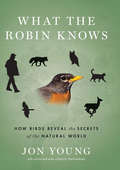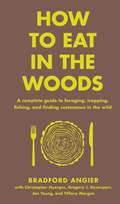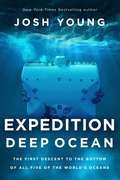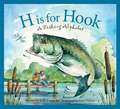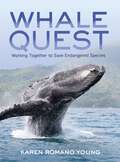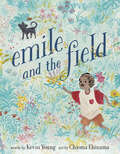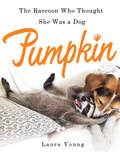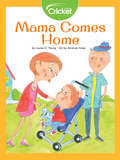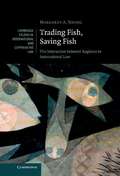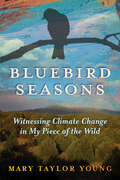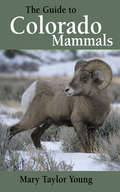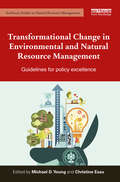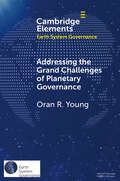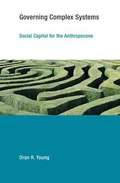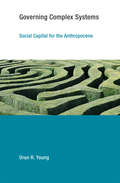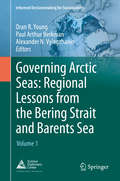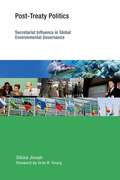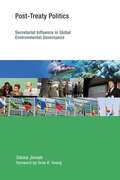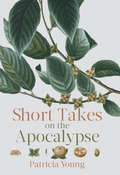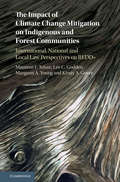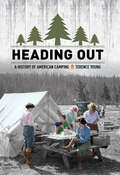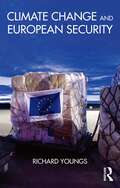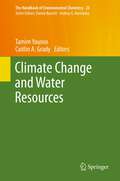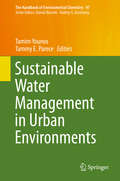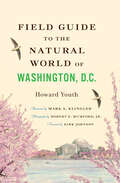- Table View
- List View
What the Robin Knows
by Jon YoungCompanion audio files are available at www.hmhbooks.com/whattherobinknows A lifelong birder, tracker, and naturalist, Jon Young is guided in his work and teaching by three basic premises: the robin, junco, and other songbirds know everything important about their environment, be it backyard or forest; by tuning in to their vocalizations and behavior, we can acquire much of this wisdom for our own pleasure and benefit; and the birds' companion calls and warning alarms are just as important as their songs. Birds are the sentries--and our key to understanding the world beyond our front door. Unwitting humans create a zone of disturbance that scatters the wildlife. Respectful humans who heed the birds acquire an awareness that radically changes the dynamic. We are welcome in their habitat. The birds don't fly away. The larger animals don't race off. No longer hapless intruders, we now find, see, and engage the deer, the fox, the red-shouldered hawk--even the elusive, whispering wren. Deep bird language is an ancient discipline, perfected by Native peoples the world over. Finally, science is catching up. This groundbreaking book unites the indigenous knowledge, the latest research, and the author's own experience of four decades in the field to lead us toward a deeper connection to the animals and, in the end, a deeper connection to ourselves.
How to Eat in the Woods: A Complete Guide to Foraging, Trapping, Fishing, and Finding Sustenance in the Wild (In the Woods)
by Jon Young Bradford AngierA comprehensive, practical, and reliable guide to finding food in the woods and living off the land, by respected wilderness survivalists. With text by wilderness survivalists, the information in How to Eat in the Woods is tried, trusted, and true. One of the most complete books written on the subject, this portable guide includes essential information on how to track, trap, kill, and prepare various types of animals; select bait, land fish, and clean and cook the catch; recognize edible plants, fruits, berries, and nuts; locate bird eggs; catch edible insects; and find potable water. Also included is information on building a fire and preparing food without utensils.
Expedition Deep Ocean: The First Descent to the Bottom of All Five Oceans
by Josh YoungThe riveting story of the exploration of the final frontier of our planet—the deep ocean—and history-making mission to reach the bottom of all five seas.Humankind has explored every continent on earth, climbed its tallest mountains, and gone into space. But the largest areas of our planet remain largely a mystery: the deep oceans. At over 36,000 feet deep, there areas closest to earth&’s core have remained nearly impossible to reach—until now. Technological innovations, engineering breakthroughs and the derring-do of a team of explorers, led by explorer Victor Vescovo, brought together an audacious global quest to dive to the deepest points of all five oceans for the first time in history. The expedition pushed technology to the limits, mapped hidden landscapes, discover previously unknown life forms and began to piece together how life in the deep oceans effects our planet—but it was far from easy. Expedition Deep Ocean is the inside story of this exploration of one of the most unforgiving and mysterious places on our planet, including the site of the Titanic wreck and the little-understood Hadal Zone. Vescovo and his team would design the most advanced deep-diving submersible ever built, where the pressure on the sub is 8 tons per square inch—the equivalent of having 292 fueled and fully loaded 747s stacked on top of it. And then there were hurricane-laden ocean waters and the byzantine web of global oceanography politics. Expedition Deep Ocean reveals the marvelous and other-worldly life found in all five deep ocean trenches, including several new species that have posed as of yet unanswered questions about survival and migration from ocean to ocean. Then there are the newly discovered sea mounts that cause tsunamis when they are broken by shifting subduction plates and jammed back into the earth crust, something that can now be studied to predict future disasters. Filled with high drama, adventure and the thrill of discovery, Expedition Deep Ocean celebrates courage and ingenuity and reveals the majesty and meaning of the deep ocean.
H Is for Hook: A Fishing Alphabet
by Judy YoungFrom A to Z all that is fishing is explained in this illustrated picture book using poetry and prose. Topics include angler, catch and release, fly-fishing, tackle, and more.
Whale Quest: Working Together to Save Endangered Species
by Karen Romano YoungDecades of commercial whaling nearly decimated a variety of whales considered a keystone species. Keystone species are indicators of the overall health of Earth's habitats. While whales have made a comeback through an international ban on commercial whaling, they are still threatened with extinction. Global warming, water and noise pollution, and commercial shipping and fishing are among the most serious threats to whale survival. Meet the scientists, citizen scientists, researchers, whale watching guides, and other concerned citizens who are working together to protect whale populations around the globe. Learn about whale biology, habitats, and behavior, and discover more about the high-technology tools that help researchers in their work.
Emile and the Field
by Kevin YoungIn this lyrical picture book from an award-winning poet, a young boy cherishes a neighborhood field throughout the changing seasons. With stunning illustrations and a charming text, this beautiful story celebrates a child's relationship with nature. There was a boynamed Emilewho fellin love with a field.It was wideand blue--and if you could haveseen itso would've you.Emile loves the field close to his home--in spring, summer, and fall, when it gives him bees and flowers, blossoms and leaves. But not as much in winter, when he has to share his beautiful, changeable field with other children...and their sleds. This relatable and lyrical ode to one boy's love for his neighborhood field celebrates how spending time in nature allows children to dream, to imagine...and even to share.
Pumpkin: The Raccoon Who Thought She Was a Dog
by Laura L. YoungAs a baby, Pumpkin the Raccoon was abandoned by her parents after falling out of a tree and breaking her leg. Taken in by a family with two rescue dogs, Toffee and Oreo, Pumpkin gained a new set of "parents" and a life of luxury in the Bahamas.Pumpkin: The Raccoon Who Thought She Was a Dog is a sweet, unique look at an adorable household pet, captured in gorgeous, never-before-seen photographs in luxurious settings. Pumpkin's message is that friendship and love can be found in the most unlikely of companions. With a lot of personality, and a little bit of mischief, Pumpkin will capture hearts all around the world.
Mama Comes Home
by Louise O. YoungOn a trip in the stroller, a little boy sees animals, cars, and his mama.
Trading Fish, Saving Fish
by Margaret A. YoungNumerous international legal regimes now seek to address the global depletion of fish stocks, and increasingly their activities overlap. The relevant laws were developed at different times by different groups of states. They are motivated by divergent economic approaches, influenced by disparate non-state actors, and implemented by separate institutions such as the World Trade Organisation and the United Nations Food and Agriculture Organisation. Margaret Young shows how these and other factors affect the interaction between regimes. Her empirical and doctrinal analysis moves beyond the discussion of conflicting norms that has dominated the fragmentation debate. Case-studies include the negotiation of new rules on fisheries subsidies, the restriction of trade in endangered marine species and the adjudication of fisheries import bans. She explores how regimes should interact, in fisheries governance and beyond, to offer insights into the practice and legitimacy of regime interaction in international law.
Bluebird Seasons: Witnessing Climate Change in My Piece of the Wild
by Mary Taylor YoungIn this A Sand County Almanac for the twenty-first century, nature writer and zoologist Mary Taylor Young tells the story of the growing effects of climate change on her land in the pine-covered foothills of southern Colorado. Climate change wasn't yet on the public radar when Young and her husband bought their piece of the wild in 1995. They built a cabin and set up a trail of bluebird nest boxes, and Mary began a nature journal of her observations, delighting in the ceaseless dramas, joys, and tragedies that are the fabric of life in the wild. But changes greater than the seasonal cycles of nature became evident over time: increasing drought, trees killed by plagues of beetles, wildfires, catastrophic weather, bears entering hibernation later and thinner, the decline of some familiar birds, and the appearance of new species. Their journal of sightings over twenty-five bluebird seasons, she realized, was a record of climate change happening, not in an Indonesian rainforest or on an Antarctic ice sheet but in their own natural neighborhood. Using the journal as a chronicle of change, Young tells a story echoed in everyone's lives and backyards. But it's not time to despair, she writes. It's time to act. Young sees hope in the human ability to overcome great obstacles, in the energy and determination of young people, and in nature's resilience, which the bluebirds show season after season.
The Guide to Colorado Mammals
by Mary Taylor YoungMary Taylor Young's latest field guide will help you discover and learn more about Colorado's native mammals. Covering 128 species, this guide explores mammals through detailed descriptions, full-color photographs, and informative sidebars. Also includes range maps, species' descriptions, a checklist, and a glossary. Outdoor enthusiasts and armchair naturalists will be delighted with this guide.Award-winning nature writer Mary Taylor Young's love of wild things led to a degree in zoology and a life devoted to nature and the environment. She has written nine books, including The Guide to Colorado Reptiles and Amphibians. Taylor Young lives in Castle Rock, Colorado.
Transformational Change in Environmental and Natural Resource Management: Guidelines for policy excellence (Earthscan Studies in Natural Resource Management)
by Mike Young Christine EsauThe aim of this book is to catalyse global interest in the pursuit of transformational changes in natural resource and environmental management. It is shown that transformational policy reforms involve fundamental shifts in strategy with far-reaching consequences for the structure of industries, the way people behave and the resources they use. Transformational reforms typically involve a decision to change a suite of institutional arrangements that will result, within a short period of time, in a paradigm shift and the emergence of an approach that will be recognised as being totally different to the arrangements that were previously in place. Transformational change is well established in business and can deliver outstanding results. In the world of policy development, however, many transformational policy reforms flounder. Unlike incremental policy reforms, they are often seen to be politically risky and prone to failure. Using examples of success and failure, coupled with insights from practitioners and academics who have succeeded in getting transformational reforms implemented, this book presents a set of guidelines for excellence in the pursuit of transformational policy reforms. It includes detailed case studies from Australia, China, Europe, New Zealand, South-east Asia and the USA.
Addressing the Grand Challenges of Planetary Governance: The Future of the Global Political Order (Elements in Earth System Governance)
by Oran R. YoungThe world today confronts unprecedented needs for governance having profound implications for human well-being that are difficult - perhaps impossible - to address effectively within the prevailing global political order. This makes it pertinent to ask whether we must assume that the global order will continue during the foreseeable future to take the form of a state-based society as we think about options for addressing these challenges. Treating political orders as complex systems and drawing on our understanding of the dynamics of such systems, the author explores the prospects for a critical transition in the prevailing global political order. Individual sections analyze constitutive pressures, systemic forces, tipping elements, the effects of scale, the defining characteristics of potential successors to the current order, and pathways to a new order. In the process, seeking to make a more general contribution to our understanding of critical transitions in large political orders.
Governing Complex Systems: Social Capital for the Anthropocene
by Oran R. YoungThe onset of the Anthropocene, an era in which human actions have become major drivers of change on a planetary scale, has increased the complexity of socioecological systems. Complex systems pose novel challenges for governance because of their high levels of connectivity, nonlinear dynamics, directional patterns of change, and emergent properties. Meeting these challenges will require the development of new intellectual capital. In this book, Oran Young argues that to achieve sustainable outcomes in a world of complex systems, we will need governance systems that are simultaneously durable enough to be effective in guiding behavior and agile enough to adapt to rapidly changing circumstances. While some insights from past research on governance remain valid in this setting, Young argues that we need new social capital to supplement mainstream regulatory approaches that feature rule making with an emphasis on compliance and enforcement. He explores the uses of goal setting as a governance strategy, the idea of principled governance, and the role of what is often called good governance in meeting the challenges of the Anthropocene. Drawing on his long experience operating on the science/policy frontier, Young calls for more effective collaboration between analysts and practitioners in creating and implementing governance systems capable of producing sustainable outcomes in a world of complex systems.
Governing Complex Systems: Social Capital for the Anthropocene (Earth System Governance)
by Oran R. YoungAn exploration of the need for innovative mechanisms of governance in an era when human actions are major drivers of environmental change.The onset of the Anthropocene, an era in which human actions have become major drivers of change on a planetary scale, has increased the complexity of socioecological systems. Complex systems pose novel challenges for governance because of their high levels of connectivity, nonlinear dynamics, directional patterns of change, and emergent properties. Meeting these challenges will require the development of new intellectual capital. In this book, Oran Young argues that to achieve sustainable outcomes in a world of complex systems, we will need governance systems that are simultaneously durable enough to be effective in guiding behavior and agile enough to adapt to rapidly changing circumstances. While some insights from past research on governance remain valid in this setting, Young argues that we need new social capital to supplement mainstream regulatory approaches that feature rule making with an emphasis on compliance and enforcement. He explores the uses of goal setting as a governance strategy, the idea of principled governance, and the role of what is often called good governance in meeting the challenges of the Anthropocene. Drawing on his long experience operating on the science/policy frontier, Young calls for more effective collaboration between analysts and practitioners in creating and implementing governance systems capable of producing sustainable outcomes in a world of complex systems.
Governing Arctic Seas: Volume 1 (Informed Decisionmaking for Sustainability)
by Oran R. Young Paul Arthur Berkman Alexander N. VylegzhaninGoverning Arctic Seas introduces the concept of ecopolitical regions, using in-depth analyses of the Bering Strait and Barents Sea Regions to demonstrate how integrating the natural sciences, social sciences and Indigenous knowledge can reveal patterns, trends and processes as the basis for informed decisionmaking. This book draws on international, interdisciplinary and inclusive (holistic) perspectives to analyze governance mechanisms, built infrastructure and their coupling to achieve sustainability in biophysical regions subject to shared authority. Governing Arctic Seas is the first volume in a series of books on Informed Decisionmaking for Sustainability that apply, train and refine science diplomacy to address transboundary issues at scales ranging from local to global. For nations and peoples as well as those dealing with global concerns, this holistic process operates across a ‘continuum of urgencies’ from security time scales (mitigating risks of political, economic and cultural instabilities that are immediate) to sustainability time scales (balancing economic prosperity, environmental protection and societal well-being across generations). Informed decisionmaking is the apex goal, starting with questions that generate data as stages of research, integrating decisionmaking institutions to employ evidence to reveal options (without advocacy) that contribute to informed decisions. The first volumes in the series focus on the Arctic, revealing legal, economic, environmental and societal lessons with accelerating knowledge co-production to achieve progress with sustainability in this globally-relevant region that is undergoing an environmental state change in the sea and on land. Across all volumes, there is triangulation to integrate research, education and leadership as well as science, technology and innovation to elaborate the theory, methods and skills of informed decisionmaking to build common interests for the benefit of all on Earth.
Post-Treaty Politics
by Oran R. Young Sikina JinnahSecretariats -- the administrative arms of international treaties -- -would seem simply to do the bidding of member states. And yet, Sikina Jinnah argues in Post-Treaty Politics, secretariats can play an important role in world politics. On paper, secretariats collect information, communicate with state actors, and coordinate diplomatic activity. In practice, they do much more. As Jinnah shows, they can influence the allocation of resources, structures of interstate cooperation, and the power relationships between states.Jinnah examines secretariat influence through the lens of overlap management in environmental governance -- how secretariats help to manage the dense interplay of issues, rules, and norms between international treaty regimes. Through four case studies, she shows that secretariats can draw on their unique networks and expertise to handle the challenges of overlap management, emerging as political actors in their own right. After presenting a theory and analytical framework for analyzing secretariat influence, Jinnah examines secretariat influence on overlap management within the Convention on Biological Diversity (CBD), two cases of overlap management in the World Trade Organization, as well as a case in which the Convention on International Trade in Endangered Species (CITES) secretariat failed to influence political outcomes despite its efforts to manage overlap. Jinnah argues that, even when modest, secretariat influence matters because it can establish a path-dependent dynamic that continues to guide state behavior even after secretariat influence has waned.
Post-Treaty Politics
by Oran R. Young Sikina JinnahSecretariats -- the administrative arms of international treaties -- -would seem simply to do the bidding of member states. And yet, Sikina Jinnah argues in Post-Treaty Politics, secretariats can play an important role in world politics. On paper, secretariats collect information, communicate with state actors, and coordinate diplomatic activity. In practice, they do much more. As Jinnah shows, they can influence the allocation of resources, structures of interstate cooperation, and the power relationships between states.Jinnah examines secretariat influence through the lens of overlap management in environmental governance -- how secretariats help to manage the dense interplay of issues, rules, and norms between international treaty regimes. Through four case studies, she shows that secretariats can draw on their unique networks and expertise to handle the challenges of overlap management, emerging as political actors in their own right. After presenting a theory and analytical framework for analyzing secretariat influence, Jinnah examines secretariat influence on overlap management within the Convention on Biological Diversity (CBD), two cases of overlap management in the World Trade Organization, as well as a case in which the Convention on International Trade in Endangered Species (CITES) secretariat failed to influence political outcomes despite its efforts to manage overlap. Jinnah argues that, even when modest, secretariat influence matters because it can establish a path-dependent dynamic that continues to guide state behavior even after secretariat influence has waned.
Short Takes on the Apocalypse
by Patricia YoungThe poems in this collection originated as a response to Elmore Leonard's "Ten Rules of Writing" and metamorphosed into poetic responses to quotations and epigraphs on a variety of subjects.
The Impact of Climate Change Mitigation on Indigenous and Forest Communities: International, National and Local Law Perspectives on REDD+
by Young Tehan Maureen F Godden Lee C Margaret A Gover Kirsty AThe international legal framework for valuing the carbon stored in forests, known as 'Reducing Emissions from Deforestation and Forest Degradation' (REDD+), will have a major impact on indigenous peoples and forest communities. The REDD+ regime contains many assumptions about the identity, tenure and rights of indigenous and local communities who inhabit, use or claim rights to forested lands. The authors bring together expert analysis of public international law, climate change treaties, property law, human rights and indigenous customary land tenure to provide a systemic account of the laws governing forest carbon sequestration and their interaction. Their work covers recent developments in climate change law, including the Agreement from the Conference of the Parties in Paris that came into force in 2016. The Impact of Climate Change Mitigation on Indigenous and Forest Communities is a rich and much-needed new contribution to contemporary understanding of this topic.
Heading Out: A History of American Camping (American Institutions And Society Ser.)
by Terence YoungWho are the real campers? Through-hiking backpackers traversing the Appalachian Trail? The family in an SUV making a tour of national parks and sleeping in tents at campgrounds? People committed to the RV lifestyle who move their homes from state to state as season and whim dictate? Terence Young would say: all of the above. Camping is one of the country's most popular pastimes—tens of millions of Americans go camping every year. Whether on foot, on horseback, or in RVs, campers have been enjoying themselves for well more than a century, during which time camping’s appeal has shifted and evolved. In Heading Out, Young takes readers into nature and explores with them the history of camping in the United States.Young shows how camping progressed from an impulse among city-dwellers to seek temporary retreat from their exhausting everyday surroundings to a form of recreation so popular that an industry grew up around it to provide an endless supply of ever-lighter and more convenient gear. Young humanizes camping’s history by spotlighting key figures in its development and a sampling of the campers and the variety of their excursions. Readers will meet William H. H. Murray, who launched a craze for camping in 1869; Mary Bedell, who car camped around America for 12,000 miles in 1922; William Trent Jr., who struggled to end racial segregation in national park campgrounds before World War II; and Carolyn Patterson, who worked with the U.S. Department of State in the 1960s and 1970s to introduce foreign service personnel to the "real" America through trailer camping. These and many additional characters give readers a reason to don a headlamp, pull up a chair beside the campfire, and discover the invigorating and refreshing history of sleeping under the stars.
Climate Change and European Security (Routledge Advances in European Politics)
by Richard YoungsIt is now commonly asserted that climate change will fundamentally change international relations. It has been predicted that global warming will increase conflict within and between states, intensify food insecurity, menace the global trading system and unleash waves of migration. As a result governments are beginning to incorporate these warnings into their foreign policy initiatives. The appropriateness of their incipient responses needs to be examined in finer detail. This book looks at the impact of climate change on European Union (EU) security policy. It explores how governments are reconfiguring their geo-strategy and broader international relations in the wake of climate change warnings. The book demonstrates that although many aspects of EU foreign policies have begun to change, ‘climate security’ is not yet accorded unequivocal or sufficient priority. In doing so, Youngs argues that if climate change policies are to have significant effect they can no longer be treated as a separate area of policy but must be incorporated into the more mainstream debates pertinent to EU common foreign and security policy (CFSP). This book will be of key interest to students, scholars and practitioners of climate change and policy, energy and environmental policy, EU governance and foreign policy, European studies, international relations, geography, security studies/policy and environmental economics.
Climate Change and Water Resources (The Handbook of Environmental Chemistry #25)
by Tamim Younos Caitlin A. GradyThis volume presents nine chapters prepared by international authors and highlighting various aspects of climate change and water resources. Climate change models and scenarios, particularly those related to precipitation projection, are discussed and uncertainties and data deficiencies that affect the reliability of predictions are identified. The potential impacts of climate change on water resources (including quality) and on crop production are analyzed and adaptation strategies for crop production are offered. Furthermore, case studies of climate change mitigation strategies, such as the reduction of water use and conservation measures in urban environments, are included. This book will serve as a valuable reference work for researchers and students in water and environmental sciences, as well as for governmental agencies and policy makers.
Sustainable Water Management in Urban Environments
by Tamim Younos Tammy E. PareceThisvolume focuses on practical aspects of sustainable water management in urbanareas and presents a discussion of key concepts, methodologies, and casestudies of innovative and evolving technologies. Topics include: (1) challengesin urban water resiliency; (2) water and energy nexus; (3) integrated urbanwater management; and (4) water reuse options (black water, gray water,rainwater). This volume serves as a useful reference for students andresearchers involved in holistic approaches to water management, and as avaluable guide to experts in governmental agencies as well as planners andengineers concerned with sustainable water management systems in urbanenvironments.
Field Guide to the Natural World of Washington, D.C.
by Howard YouthA field guide to plants and animals commonly found in the nation's capital.Winner of the Design and Effectiveness Award of the Washington PublishersNature awaits discovery at almost every turn in the complex ecosystem of Washington, D.C. In parks large and small, within the District's gardens, and on public streets, there is tremendous biodiversity. In Field Guide to the Natural World of Washington, D.C., naturalist Howard Youth takes us on an urban safari, describing the wild side of the nation's capital.Beyond the abundant wildlife that can be seen in every neighborhood, Washington boasts a large park network rich in natural wonders. A hike along the trails of Rock Creek Park, one of the country’s largest and oldest urban forests, quickly reveals white-tailed deer, eastern gray squirrels, and little brown bats. Mayapples, Virginia bluebells, and red mulberry trees are but a few of the treasures found growing at the National Arboretum. A stroll along the Potomac and Anacostia Rivers might reveal stealthy denizens such as bullfrogs, largemouth bass, and common snapping turtles. Detailed drawings by Carnegie artist Mark A. Klingler and photography by Robert E. Mumford, Jr., reveal the rich color and stunning beauty of the flora and fauna awaiting every D.C. naturalist.Whether seeking a secluded jog or an adventurous outing, residents and tourists alike will find this handsome guide indispensable for finding oases away from the noise of the city.
